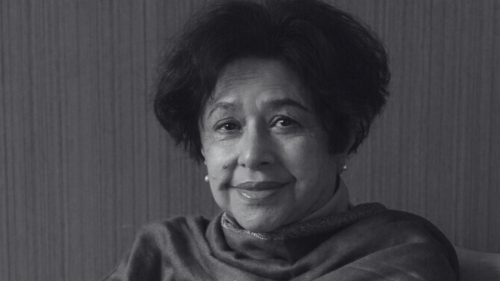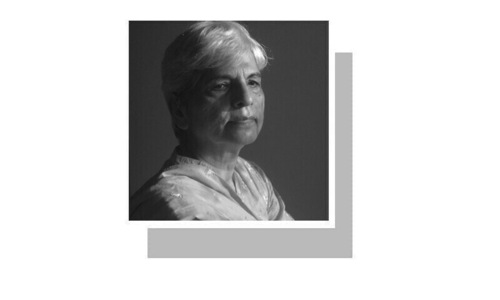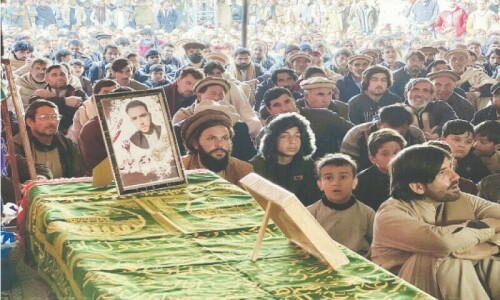In her latest solo show, ‘All that Glitters is Not Home’, on display at Canvas Gallery, Masuma Halai Khwaja masterfully explores the intersections of culture, tradition and political upheaval, through textile art. Her work transcends the medieval associations often tethered to the medium, as she reinterprets historical tapestries to comment on the contemporary socio-political landscape.
The artist is renowned for her deep engagement with textiles. Sourcing materials from local markets in Karachi, she integrates fragments of traditional embroidery and fabric into her art, reimagining these discarded pieces to forge new narratives. Her use of monochromatic Flemish, French and Italian tapestries as a backdrop creates a rich, yet understated, foundation for the vibrant stories she tells in the foreground. These muted tapestries, sourced and repurposed, evoke emotional depth and tactile complexity, juxtaposing old world craftsmanship with modern interpretations.
Khwaja’s work delves deeply into the themes of fragmentation, globalisation, and cultural erosion. By cutting and reassembling embroidered fragments — primarily from Pakistan’s Sindhi traditions — she crafts narratives that intertwine the histories of both the embroidery and the fabric beneath. These fractured elements reflect a globalised world where cultural traditions are often eroded, repurposed or discarded. Her work becomes a testament to the artist’s acute observation of shifting cultural, social and political dynamics, offering layered meanings that speak to both past legacies and present realities.
One of the standout works in this exhibition is the large oil painting titled For the Love of the Rose. Unlike her other works, this piece features no fabric or embroidery, yet its impact is equally arresting. The richly painted red rose, with its folds of silky texture, holds a depth and complexity that captivates the viewer. For Khwaja, the rose signifies the global north and the burdens of post-colonialism. This imagery, painted with such precision and intent, offers a striking contrast to the textured, stitched narratives found elsewhere in the exhibition, yet remains thematically connected in its examination of power and history.
This singular exhibition uses textiles sourced from across the region to explore history, tradition and cultural evolution
The Arrival of the Beloved I and II feature acrylics on paper. These pieces incorporate the imagery of the famous terracotta soldiers — thousands of life-sized clay warriors who stand guard over the tomb of China’s first emperor, Qin Shi Huang. In Khwaja’s interpretation, the terracotta soldiers serve as metaphors for China’s growing influence in Pakistan. The rose petals strewn on the soldiers in these works become a playful yet biting commentary on the influx of Chinese investment, subtly critiquing the geopolitical entanglements at play.

In another work, Exodus, Khwaja employs an old kilim as her canvas, on which two terracotta soldiers and a horse are depicted. The kilim, with its motifs of movement and migration, becomes a poignant commentary on the contemporary reality of land deals and the increasing presence of foreign powers in Pakistan. The fragmented embroidery, combined with the visual narrative of the kilim, underscores the artist’s unease with the rapid changes taking place in her homeland.
Similarly, Casting Nets at the Ebbing Tide is a textile collage that speaks to the shifting tides of global power. Stitched onto a Flemish tapestry, the piece reflects the rise of the East and the waning influence of the West, all while questioning the persistent allure of migration.
Her work deftly interweaves personal narratives of migration with broader questions of displacement, belonging and power. In her artist statement, she reflects on the significance of migration, drawing parallels between marriage and exile, and invoking the Urdu term for expats, “samundar paar [across the sea].”

Her work All That Glitters Is Not Home is particularly emblematic of these themes. The depiction of sea waves rendered in zardozi — a South Asian embroidery technique associated with bridal trousseaus — invokes both the romance and uncertainty of these journeys, connecting the personal with the political. It explores the tension between aspirations and reality, glittering promise and disillusionment.
Through her intricate, multi-layered works, Khwaja challenges viewers to reconsider their assumptions about history, tradition and power. Her works capture the complexity of a world in flux, where the past and present are constantly colliding, fragmenting and reshaping one another.
‘All that Glitters is Not Home’ was on display at Canvas Gallery in Karachi from August 20-29, 2024
Rumana Husain is a writer, artist and educator. She is the author of two coffee-table books on Karachi, and has authored and illustrated 75 children’s books
Published in Dawn, EOS, September 8th, 2024
















































Dear visitor, the comments section is undergoing an overhaul and will return soon.